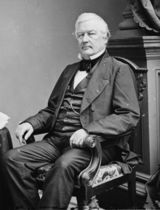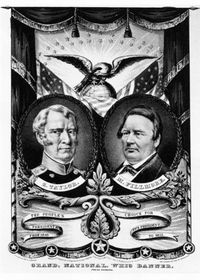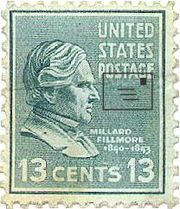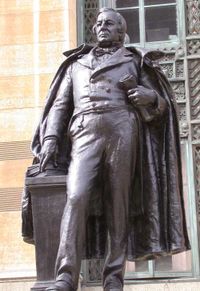Millard Fillmore
2007 Schools Wikipedia Selection. Related subjects: USA Presidents
| Millard Fillmore | |
 |
|
|
|
|
|---|---|
| In office July 9, 1850 – March 4, 1853 |
|
| Vice President(s) | none |
| Preceded by | Zachary Taylor |
| Succeeded by | Franklin Pierce |
|
12th Vice President of the United States
|
|
| In office March 4, 1849 – July 9, 1850 |
|
| President | Zachary Taylor |
| Preceded by | George Dallas |
| Succeeded by | William R. King |
|
|
|
| Born | January 7, 1800 Summerhill, New York |
| Died | March 8, 1874 Buffalo, New York |
| Political party | Whig |
| Spouse | Abigail Powers Fillmore (1st wife) Mrs. Caroline Carmichael McIntosh (2nd wife) |
| Religion | Unitarian |
| Signature | |
Millard Fillmore ( January 7, 1800 – March 8, 1874) was the thirteenth President of the United States, serving from 1850 until 1853, and the last member of the Whig Party to hold that office. He succeeded from the Vice Presidency on the death of President Zachary Taylor, who died of acute gastroenteritis, becoming the second U.S. President to assume the office in this manner. Fillmore was never elected President in his own right; after serving out Taylor's term he was not nominated for the Presidency by the Whigs in the 1852 Presidential election, and in 1856 he again failed to win election as President as the Know Nothing Party candidate.
Early life
Fillmore was born in poverty to Nathaniel Fillmore and Phoebe Millard Fillmore in Summerhill, New York as the second of nine children and the eldest son. Though a Unitarian in later life, Fillmore was descended from Scottish Presbyterians on his father's side, and English dissenters on his mother's. He was first apprenticed to a fuller to learn the clothmaking trade. He struggled to obtain an education under frontier conditions, attending New Hope Academy for six months. Later, Fillmore bought out his apprenticeship and moved to Buffalo, New York to continue his studies. He was admitted to the bar in 1823 and began his law practice in East Aurora. In 1828, he was elected to the New York Legislature and served from 1829 to 1831.
Early political career
Fillmore was elected as a Whig to the 23rd Congress (1833-1835); he was also elected, to the 25th, 26th and 27th Congresses (1837-1843). He declined to be a candidate for renomination in 1842. He was an unsuccessful candidate for governor of New York in 1844. He was state comptroller of New York from 1848 to 1850.
Vice-Presidency

Having worked his way up through the Whig Party in New York, Fillmore was selected as Zachary Taylor's running mate. (It was thought that the obscure, self-made candidate from New York would complement Taylor, a slave-holding military man from the south.)
Taylor and Fillmore disagreed on the slavery issue in the new western territories taken from Mexico in the Mexican-American War. Taylor wanted the new states to be free states, while Fillmore supported slavery in those states as a means of appeasing the South. In his own words: "God knows that I detest slavery, but it is an existing evil ... and we must endure it and give it such protection as is guaranteed by the Constitution."
Fillmore presided over the Senate during the months of nerve-wracking debates over the Compromise of 1850. He made no public comment on the merits of the compromise proposals, but a few days before President Taylor's death, Fillmore suggested to the president that, should there be a tie vote on Henry Clay's bill, he would vote in favour of it.
Presidency 1850–1853
Policies
Fillmore ascended to the presidency upon the sudden and unexpected death of President Taylor in July 1850. The sudden change in leadership also signaled an abrupt political shift in the administration. Taylor's cabinet resigned and President Fillmore at once appointed Daniel Webster to be Secretary of State, thus proclaiming his alliance with the moderate Whigs who favored the Compromise of 1850.
A bill to admit California to the Union still aroused all the violent arguments for and against the extension of slavery without any progress toward settling the major issues. Clay, exhausted, left Washington to recuperate, throwing leadership upon Senator Stephen A. Douglas of Illinois. At this critical juncture, President Fillmore announced his support of the Compromise of 1850.
On August 6, 1850, he sent a message to Congress recommending that Texas be paid to abandon her claims to part of New Mexico. This helped shift a critical number of northern Whigs in Congress away from their insistence upon the Wilmot Proviso—the stipulation that all land gained by the Mexican War must be closed to slavery.
Douglas's effective strategy in Congress combined with Fillmore's pressure gave impetus to the Compromise movement. Breaking up Clay's single legislative package, Douglas presented five separate bills to the Senate:
- Admit California as a free state.
- Settle the Texas boundary and compensate the state for lost lands.
- Grant territorial status to New Mexico.
- Place Federal officers at the disposal of slaveholders seeking escapees—the Fugitive Slave Act.
- Abolish the slave trade in the District of Columbia.
Each measure obtained a majority, and, by September 20, President Fillmore had signed them into law. Webster wrote, "I can now sleep of nights."
Another important legacy of Fillmore's administration was the sending of Commodore Matthew C. Perry to open Japan to Western trade, though Perry did not reach Japan until Franklin Pierce had replaced Fillmore as president.
Administration and Cabinet
| OFFICE | NAME | TERM |
| President | Millard Fillmore | 1850–1853 |
| Vice President | None | |
| Secretary of State | Daniel Webster | 1850–1852 |
| Edward Everett | 1852–1853 | |
| Secretary of the Treasury | Thomas Corwin | 1850–1853 |
| Secretary of War | Charles Magill Conrad | 1850–1853 |
| Attorney General | John J. Crittenden | 1850–1853 |
| Postmaster General | Nathan K. Hall | 1850–1852 |
| Samuel D. Hubbard | 1852–1853 | |
| Secretary of the Navy | William A. Graham | 1850–1852 |
| John P. Kennedy | 1852–1853 | |
| Secretary of the Interior | Thomas McKennan | 1850 |
| Alexander Stuart | 1850–1853 | |
Supreme Court appointments
Fillmore appointed the following Justices to the Supreme Court of the United States:
- Benjamin Robbins Curtis - 1851
States admitted to the Union
- California – September 9, 1850
Legacy
Some northern Whigs remained irreconcilable, refusing to forgive Fillmore for having signed the Fugitive Slave Act. They helped deprive him of the Presidential nomination in 1852.
Within a few years it was apparent that although the Compromise had been intended to settle the slavery controversy, it served rather as an uneasy sectional truce.
Later life
Fillmore was one of the founders of the University of Buffalo. The school was chartered by an act of the New York State Legislature on May 11, 1846, and at first was only a medical school . Fillmore was the first Chancellor, a position he maintained while both Vice President and President. Upon completing his presidency, Fillmore returned to Buffalo, where he continued to serve as chancellor.
While touring Europe in 1855, Fillmore was offered an honorary Doctor of Civil Law (D.C.L.) degree by the University of Oxford. Fillmore turned down the honour, explaining that he had neither the "literary nor scientific attainment" to justify the degree. He is also quoted as having explained that he "lacked the benefit of a classical education" and could not, therefore, understand the Latin text of the diploma, then joking that he believed "no man should accept a degree he cannot read."
By 1856, Fillmore's Whig Party had ceased to exist, having fallen apart due to dissension over the slavery issue, and especially the Kansas-Nebraska Act of 1854. Fillmore refused to join the new Republican Party, where many former Whigs found refuge. Instead, Fillmore joined the anti-immigrant, anti-Catholic American Party, the political organ of the Know-Nothing movement. He would run in the election of 1856 as their candidate, attempting to win a non-consecutive second term as President (a feat that has been accomplished only once in American politics, by Grover Cleveland). Fillmore finished third, carrying only the state of Maryland and its eight electoral votes, but he won 21.6% of the popular vote, one of the best showings ever by a Presidential third-party candidate.
On February 10, 1858, he married a widow Mrs. Caroline Carmichael McIntosh.
Throughout the Civil War, he opposed President Lincoln and during Reconstruction supported President Johnson. He commanded a corps of home guards during the Civil War.
He died at 11:10 p.m. on March 8, 1874, of the after-effects of a stroke, with his last words alleged to be, upon being fed some soup, "the nourishment is palatable." On January 7 each year, a ceremony is held at his gravesite in the Forest Lawn Cemetery in Buffalo.
Trivia
- The myth that Millard Fillmore installed the White House's first bathtub was started by H. L. Mencken in a joke column published on December 28, 1917 in the New York Evening Mail. (See: Bathtub hoax)
- A bookworm who found the White House devoid of books, Millard Fillmore initiated the White House library.
- As of 2006, Millard Fillmore remains the last U.S. president who was neither a Democrat nor a Republican (although Abraham Lincoln was re-elected in 1864 running on the Union Ticket instead of Republican, with Democrat Andrew Johnson as his running mate).
- Fillmore, Utah, located in Millard County, was named after this president.
- ESPN anchor Neil Everett often makes references to Millard Fillmore while hosting Sportscenter.
- Fillmore County, Minnesota was named after this president.

